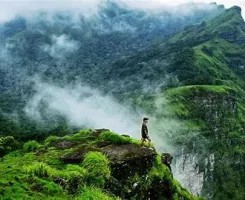
Manas National Park
Package
9999 to 12999
9999 to 12999
Duration
2 to 4 Days
2 to 4 Days
Best time to visit
Nov-Apr
Nov-Apr
Theme
Wildlife
Wildlife
Manas National Park Travel Guide
Manas National Park is a UNESCO World Heritage Site located in Assam, India. This park is not only a wildlife sanctuary but also holds immense historical and cultural significance. It is famous for being one of the most biodiverse areas in the world, home to rare and endangered species like the Indian rhinoceros, Bengal tiger, and pygmy hog. The park also has a rich history, with ancient ruins dating back to the 6th century.Top Attractions in Manas National Park
- Explore the wildlife safari to spot tigers, elephants, and rhinoceros.
- Visit the ancient ruins of the Manas National Park dating back to the 6th century.
- Experience the unique culture of the local Bodo tribes.
- Enjoy river rafting in the Manas River.
Manas National Park is Famous for
Biodiversity and rare wildlife conservation.Top Attractions in Manas National Park
- Wildlife safari to spot tigers, elephants, and rhinoceros
- Ancient ruins dating back to the 6th century
- Unique culture of the local Bodo tribes
- River rafting in the Manas River
What's Great about Travelling to Manas National Park?
- Perfect destination for wildlife enthusiasts
- Great for nature lovers and photographers
- Opportunity to explore the rich cultural heritage
What's Not So Great about Travelling to Manas National Park?
- Limited accommodation options
- Remote location might be challenging for some travelers
- Weather can be unpredictable
Travel Tips for Manas National Park
- Obtain the necessary permits for entry into the national park
- Wear appropriate clothing and footwear for wildlife safaris
- Respect the local culture and customs
Important Manas National Park trip information
- Ideal Duration: 3-4 days to explore the park thoroughly
- Best Time to Visit: November to April for the best wildlife sightings
- Nearby Airports and Railway Stations: The nearest airport is Salonibari Airport in Tezpur, and the nearest railway station is in Barpeta Road.
Top 10 Places to visit in Manas National Park
Per Person
40,000
*EXCLUDING APPLICABLE TAXES Per Person
34,990
*EXCLUDING APPLICABLE TAXES Per Person
18,000
*EXCLUDING APPLICABLE TAXES Per Person
24,400
*EXCLUDING APPLICABLE TAXES Per Person
15,000
*EXCLUDING APPLICABLE TAXES Per Person
19,000
*EXCLUDING APPLICABLE TAXES 5.0 Ratings
( 8 Reviews )
( 8 Reviews )
FAQ's on Manas National Park
Q1: What is the best time to visit Manas National Park?
The best time to visit Manas National Park is from November to April when the weather is pleasant, and wildlife sightings are abundant. This period also coincides with the dry season, making it easier to spot animals near water sources. However, for bird enthusiasts, the monsoon season from July to September offers a vibrant display of avian species. Consider visiting during the annual Manas Spring Festival in February for cultural performances and traditional events.
Q2: Do I need a visa to travel to Manas National Park?
Visitors to Manas National Park require a valid Indian visa to enter the country. It's advisable to check the specific visa requirements based on your nationality and duration of stay. Travelers should also ensure they have the necessary permits for visiting protected areas within the park.
Q3: What are the must-visit attractions in Manas National Park?
Manas National Park is renowned for its rich biodiversity and stunning landscapes. Must-visit attractions include the Manas River, the endangered Indian rhinoceros habitat, and the Manas Tiger Reserve. Explore the lush forests, go on wildlife safaris, and visit the ancient ruins of the Manas landscape.
Q4: Is Manas National Park a safe place to travel?
Manas National Park is generally safe for tourists, but it's essential to follow safety guidelines provided by park authorities. Avoid venturing into restricted areas, stay on designated paths during safaris, and respect the wildlife from a safe distance. Be aware of any seasonal risks such as flooding during the monsoon season.
Q5: What is the local currency in Manas National Park and can I use credit cards?
The local currency in Manas National Park is the Indian Rupee (INR). While credit cards are accepted in some hotels and larger establishments, it's advisable to carry cash for transactions in smaller shops and local markets. ATMs may not be readily available in remote areas, so plan accordingly.
Q6: What is the local cuisine like in Manas National Park?
Manas National Park offers a taste of Assamese cuisine, known for its flavorful dishes rich in spices and herbs. Try local specialties like Assam tea, fish curries, bamboo shoot delicacies, and traditional sweets like pitha. Vegetarian options are also available, and visitors with dietary restrictions can find suitable meals in the region.
Q7: What transportation options are available in Manas National Park?
Transportation options in Manas National Park include buses, taxis, and private cars for getting around the region. Wildlife safaris within the park are typically conducted in designated vehicles accompanied by trained guides. Visitors can also opt for organized tours that include transportation and accommodation arrangements.
Q8: Are there any cultural norms or etiquette I should be aware of when visiting Manas National Park?
When visiting Manas National Park, it's important to respect the local customs and traditions of the indigenous communities in the region. Dress modestly, seek permission before taking photographs of locals, and follow eco-friendly practices to preserve the natural environment. Learn about the cultural heritage of the Bodo tribes and participate in community-based tourism activities for a deeper cultural experience.
Q9: I am a travel agent. How can I buy travel leads of Manas National Park?
Register yourself as a travel agent at agents.tripclap.com and then you can buy travel leads to Manas National Park once your account is approved. For more details contact our support team at +91-8069186564 or support@tripclap.com






